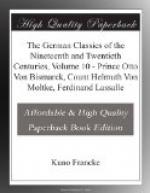The inhabitants of Mossul are a remarkable mixture of the original Chaldean populace and the Arabs, Kurds, Persians and Turks who successively have ruled over them. The common speech is Arabic.
Indshe-Bairaktar, the governor, received us with great courtesy and had us quartered with the Armenian Patriarch. The Nestorian and Jacobite Christians of Mossul have the most beautiful churches I have seen in Turkey, but they are living in discord and hatred. One of these churches happened to belong, I do not know why, to two congregations, and since everything which the one did in these sacred halls was an abomination in the eyes of the other, the beautiful vault had been divided by a brick wall directly in the centre.
Our Jacobite Patriarch was greatly troubled about having to house heretics, but he much preferred us to Nestorians or Greeks. Since no Christians, moreover, had ever been received with so much honor by the Pasha, and the most important Mussulmans came to pay us their respects, he treated us well, and even sold me a Bible in Arabic and Syrian (Chaldean).
In the northwesterly corner of the city the plateau falls off abruptly toward the river. Here the water of the Tigris is raised by a contrivance, which makes use of a high kind of derrick, leathern hose, and a rope which is pulled by a horse. The long nozzle of the hose empties into huge brick basins whence the water is distributed over fields and gardens. But only the empty areas within the walls and the fields adjacent to the city are cultivated. If only a fraction of all the water rushing past Mossul could be used for irrigation purposes this whole country would be one of the most fertile of the world. This idea undoubtedly induced the people ages ago to build the powerful stone dikes which hem in the course of the river a few hours above the city. Surely, it would not be difficult to irrigate all the fields from there, but the Arabs hovering about the city make the harvesting of the crops too uncertain.
There is a bazaar especially for the Arabs immediately outside the walls of Mossul, built there for the purpose of keeping these suspicious characters from entering the city proper. Over the confusion of many small mud-huts some slender palm trees rise to majestic heights, the last ones of the desert. These palms are like reeds grown to the proportions of trees. They are typical of the south, and give confidence to the Arabs who seem to feel that they are way up north and yet still in the land of the myrrh and the incense. Here the children of the desert congregate and, pushing their bamboo-spears into the sand—point down, squat on the ground to admire the glory of a city—even though it be a city which affects the European with the very opposite of glory, but which for hundreds of miles has no equal.




